Matcha has been a buzz word for a few years now but it’s not just trendy; matcha’s health benefits make it a real nutritional powerhouse! Did you know that even though matcha and green tea both come from the same tea plant, they are actually quite different? When we wanted to get the Matcha 101 we knew we had to reach out to the matcha experts over at Soar Organics.
We chatted with Megan Frisk from Soar Organics about matcha’s health benefits, how to properly prepare it, and her favourite matcha recipe.
WEHL: Tell us a little about yourself and what wellness means to you.
MF: My own journey with wellness is something I’ve been exploring my entire life. Having grown up in North Vancouver I’ve always been drawn towards nature and being outside. I find peace and enjoyment walking the seawall (rain or shine), or hiking through local trails with our dogs. Having battled anxiety my entire life, taking time to balance both my physical and mental wellbeing has been a large part of my personal wellness journey. Learning more and more just how connected the mind and body are has allowed me to focus on both aspects with attention and care. Nourishing my body with foods that help support my overall healing journey has been huge. However, this isn’t an “end all be all” and I’ve learned not to put restrictions on myself, which I think is an important factor to overall wellness.
WEHL: What is your personal philosophy on wellness?
MF: For me, wellness is taking what you know about your own body, mind and spirit connection, and investing in what you feel works for you. Wellness isn’t a one approach fits all, but more a personal journey of learning what you need to thrive. For one individual this may be including foods to help support healing, and for someone else this may mean learning to say no to things that don’t serve them. I believe allowing yourself to be at peace with what you have available to you and what you know you can handle is key. Saying “this isn’t working for me” or “I’ve done the best I can” and moving forward is one of the most important things I’ve come to realize.
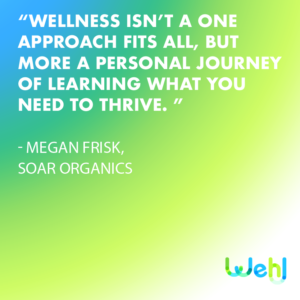
WEHL: What inspired you to start an organic matcha company?
MF: Growing up I’ve always been interested in knowing how food choices can impact our bodies; however it wasn’t until the past five years or so that I really started to educate myself on this topic. It became important for me to include a healthy balance of real foods in my diet and to eat organic when possible. Without putting pressure on the food choices I was making, I wanted to ensure I was giving my body what it needed in order to function properly.
My desire to start an organic matcha company began with my interest in sharing my passion for real foods with people. Although I’ve been a matcha fan since my early teens, I’ll admit I didn’t know a ton about this culturally rich form of tea. When my partner Chris and I (in real life too) began scratching out plans for our organic food company in late 2016, it was easy to determine that matcha was the product we initially wanted to move forward with. Our journey involved educating ourselves extensively on matcha, its history and cultivation processes. Our own passion for matcha and its numerous health benefits helped make this an easy decision.
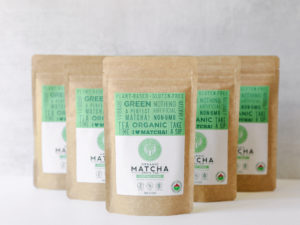 WEHL: What makes your matcha unique?
WEHL: What makes your matcha unique?
MF: We sampled many different matcha sources before deciding on our Ceremonial and Everyday products. Sourcing a certified organic matcha was one of the first things we looked for. We also wanted to ensure our organic matcha was from a quality source. We take pride in knowing our organic matcha is tested for radiation, heavy metals and arsenic through lab analysis. Oxidation, which is a natural chemical process that can result in the loss of nutrients and quality of matcha over time, can occur when matcha is exposed to light, air, heat and moisture. To prevent oxidation, our matcha is packaged and sealed in Japan upon being ground to help maintain overall quality and freshness.
 WEHL: What is matcha and how is it different from green tea?
WEHL: What is matcha and how is it different from green tea?
MF: Matcha and green tea are actually both from the Camellia Sinensis tea plant. The difference lies beneath how both forms of tea are produced. Matcha is a fine powder made from specially grown and processed green tea leaves. Matcha (or tencha) leaves are shaded for a period of time before being harvested to enhance the plant’s natural chlorophyll levels. This is what gives matcha its bright green colour, and is one of the many reasons for its health benefits.
Instead of steeping the tea, as you would with green tea leaves, matcha is used in powdered form. The tencha leaves are fully stemmed and de-veined before being milled into matcha powder. Since the entire green tea leaf is being consumed with matcha, its nutritional value is much more than that of green tea. For this reason, matcha naturally contains more caffeine than ordinary green tea. With an average serving of about ½ tsp. of matcha you can expect approximately 35 mg of caffeine.
WEHL: What are some of matcha’s health benefits?
MF: Not only is matcha an incredible source of antioxidants, but it can also help you de-stress. Antioxidants help protect our bodies by encouraging healthy cell turnover and reducing free radical damage, which can contribute to the development of degenerative disease. The antioxidant Epigallocatechin-gallate (EGCG) is especially unique to matcha, and is supported by numerous studies to have positive effects on metabolism, immunity and even cardiovascular health.
Matcha is also a potent source of the amino acid L-theanine. Studies suggest that L-theanine can help promote the production of alpha brain waves, encouraging mental calmness and overall relaxation.
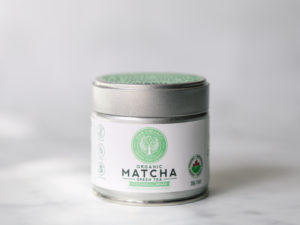
WEHL: What should people look for when they are purchasing matcha to make sure they are getting the highest quality?
MF: There are different grades of matcha that are dependent on what time of year the matcha (tencha) leaves were harvested. Higher-quality and ceremonial grades of matcha are often produced from the year’s first harvest in the spring, otherwise known as the first flush. This is when the tencha leaves are young and rich in chlorophyll. Summer and autumn harvests are commonly referred to as latte and cooking grades, and generally won’t be as sweet or rich in colour as spring harvests.
If you’re looking for a high-quality matcha the first three things you want to look at are the colour, texture and smell of your matcha. The colour should be a vibrant green, although non-organic grades are sometimes more vibrant due to the manipulation of fertilizers. The texture (or particle size) of your matcha should also be very fine – this refers to the way your matcha was milled. A high-quality matcha should be ground down using a stone-mill, which takes much longer but helps preserve nutritional value and quality since very little heat is generated. Finally, the smell of your matcha can help determine the quality. The smell obtained from a higher-quality matcha should produce a sweet, earthy and vegetal aroma.
WEHL: What’s the difference between your ceremonial and everyday matcha types?
MF: Our Ceremonial matcha is our highest quality option, derived from premium first-flush harvest green tea leaves. We often recommend our Ceremonial matcha to those who enjoy matcha straight with water, or to anyone with an appreciation for a top quality matcha powder. Our Everyday matcha is still a high-quality option, however just not as premium as our Ceremonial grade. Our Everyday option comes in a 100g pouch and is the perfect choice for daily use.
WEHL: What is the proper way to make traditional matcha?
MF: Traditional matcha tea can be prepared by using a ceremonial grade in one of two ways. Usucha, or “thin”, matcha tea can be prepared by scooping ½ tsp. of matcha powder into a sieve (or sifter) using a traditional bamboo scoop known as a chashaku. The matcha powder is sifted in order to avoid any clumps. Next, about 1/3 cup of hot water (175F/80C) is added and whisked in “M” motions with a bamboo whisk or chasen. Koicha, which refers to “thick” matcha, is prepared the same way but by adjusting the amount of matcha powder and water to form a delicious and syrupy matcha tea. Add 1 tsp. of matcha powder with 2-1/2 tbs. of water to make traditional koicha.
Traditional matcha is enjoyed as is, with no other ingredients included. The rich umami flavour that results from ceremonial grades has been enjoyed in Japanese tea ceremonies for thousands of years.
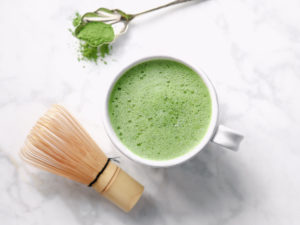 WEHL: We’ve see people use a little wood whisk when making matcha; is there a substitute if you don’t have one?
WEHL: We’ve see people use a little wood whisk when making matcha; is there a substitute if you don’t have one?
MF: Having a traditional bamboo whisk (chasen) on hand is a great way to prepare your matcha; however you can definitely opt to use something else if you don’t have one. One of my favourite kitchen substitutes to use is a flat whisk, or roux whisk. Matcha isn’t naturally water-soluble and needs to be whisked in order for the matcha powder to dissolve. Whisk in the same “M” motions to ensure no clumps remain.
WEHL: How should matcha be stored and how long is it usually good for after opening?
MF: We recommend storing your matcha in the fridge and consuming it within two months after opening to ensure maximum freshness and quality. After this two-month period your matcha will still be fine to consume; however it may begin to lose aspects of its flavour, colour and nutritional value. The cooler temperatures of your fridge will help slow down the natural oxidation process that occurs once matcha has been exposed to air.
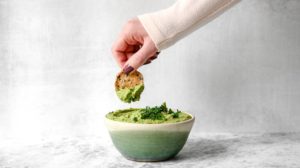 WEHL: Do you have a favourite recipe that you’d like to share that uses matcha?
WEHL: Do you have a favourite recipe that you’d like to share that uses matcha?
MF: One of my favourite flavour combos is actually the combination of matcha and miso. This past month I’ve really been enjoying our Creamy Matcha Miso Hummus recipe. If you have a high-powered blender this recipe is easy to recreate. You can check out the full recipe here!
WEHL: You’ve partnered with Canadian Feed the Children; tell us about this partnership and why you chose to work with them.
MF: We’re very happy to have partnered with Canadian Feed The Children (CFTC). $0.50 from every Soar Organics matcha product sold is donated to help support the organization.
CFTC is a Canadian-based non-profit organization that works through local partners in Canada and around the world to help promote long-term change for children, families and communities. The organization works directly with Indigenous communities in Canada, and with partners internationally in Bolivia, Ethiopia, Ghana and Uganda. Partnering with an organization whose values aligned with our own personal beliefs was essential. CFTC’s community-led approach to development emphasizes food security, education and capacity-building to help foster change in communities. The organization considers critical issues, such as gender inequality and climate change adaptation, in order to help promote long-term growth and change.
WEHL: Do you have any advice for an entrepreneur who’s interested in building a socially and environmentally conscious business?
MF: If you have an idea, don’t be afraid to move forward with it. Start small and start simple; there’s always room for growth once you have your foundation. And don’t be afraid to say no to things that don’t serve your own beliefs. We’ve chosen to not offer a bamboo whisk at this point in our journey, as we have yet to source one that aligns with our values. The business world will present you with options that may help drive your business forward but that you may not agree entirely with. As a small business you may not feel like you’re making a huge difference; however it’s the gravity of all those small contributions that can help promote change in our world.
Connect with Megan and Soar Organics:
- Web: www.soarorganics.com
- Email: [email protected]
We invite you to join our all-in-one healthy lifestyle app at Wehl.com!


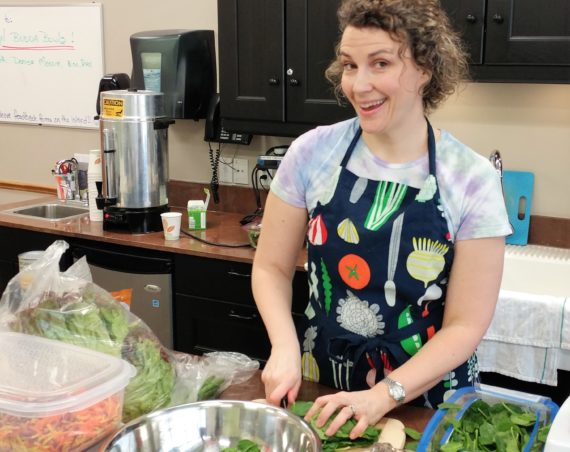

1 Comment
Sherika
This is great information. I have always been hearing about matcha but have never tried it… I will definitely try it now